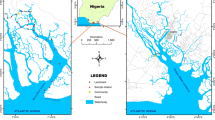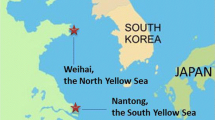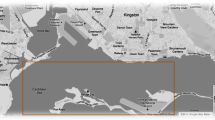Abstract
A steady-state condition of polychlorinated biphenyl (PCB) pollution is evident in cod-liver oil samples of fish collected from the Baltic area between 1971 and 1989. Spatial differences in the concentration of congeners and isomers of these chemicals between the Baltic Sea and other areas in the north and northeastern part of the Atlantic Ocean appeared to be rather small. A site relatively distant from the PCB sources of the European continent, an open ocean environment near Iceland, showed a fivefold lower concentration of many PCB congeners than the Baltic Sea. The open and deep waters of the North Sea and Norwegian Sea differed by a factor of 2 in the total concentrations of PCBs when compared with the southern Baltic proper. Continuous release of PCBs into the atmosphere over Europe, its drift from distant sources in North America, and further aerial transport and deposition due to dominating air masses movement from the west and southwest are postulated to be the main routes of PCBs pollution and a reason for the small differences in concentration between the marine areas assessed.
Similar content being viewed by others
References
Ballschmiter K, Buchert H, Bihler S, Zell M (1981) Baseline studies of the global pollution. IV. The pattern of pollution by organochlorine compounds in the North Atlantic as accumulated by fish. Fresenius Z Anal Chem 306:323–339
Barrie LA, Gregor D, Hargrave B, Lake R, Muir D, Shearer R, Tracey B, Bidleman T (1992) Arctic contaminants: sources, occurrence and pathways. Sci Total Environ 122:1–74
Bletchly JD (1984) Polychlorinated biphenyls. Production, current use and possible rates of further disposal in OECD member countries. In: Barres MC, Koeman H, Visser R, (eds) PCB seminar. Ministry of Housing, Physical Planning, and Environment, Amsterdam, pp 343–372
De Voogt P, Wells DE, Reutergardh L, Brinkman UATh (1990) Biological activity, determination and occurrence of planar, mono- and di-ortho PCBs. Int J Environ Anal Chem 40:1–46
Falandysz J (1986) Organochlorine pesticides and polychlorinated biphenyls in cod from the southern Baltic, 1983. Z Lebensm Unters Forsch 182:136–139
Falandysz J, Szefer P (1984) Chlorinated hydrocarbons in fish-eating birds wintering in the Gdańsk Bay, 1981–82 and 1982–83. Mar Pollut Bull 15:298–301
Falandysz J, Yamashita N, Tanabe S, Tatsukawa R (1992) Composition of PCB isomers and congeners in technical Chlorofen® formulation produced in Poland. Int J Environ Anal Chem 47:129–136
Hutzinger O, Safe S, Zitko V (1974) The chemistry of PCBs. CRC Press, Cleveland, OH
Jones KC, Sanders G, Wild SR, Burnett V, Johnston AE (1992) Evidence for a decline of PCBs and PAHs in rural vegetation and air in the United Kingdom. Nature 356:137–140
Kannan K, Falandysz J, Yamashita N, Tanabe S, Tatsukawa R (1992) Temporal trends of organochlorine concentrations in cod-liver oil from the southern Baltic proper, 1971–1989. Mar Pollut Bull 24:358–363
Kihlström JF, Berglund E (1978) An estimation of the amounts of polychlorinated biphenyls in the biomass of the Baltic. Ambio 7:175–178
Loganathan BG, Tanabe S, Hidaka Y, Kawano M, Hidaka H, Tatsukawa R (1993) Temporal trends of persistent organochlorine residues in human adipose tissue from Japan, 1928–1985. Environ Pollut 81:31–39
Muus BJ, Dahlström P (1978) Meeresfisch. BLV Verlagsges, München
Newton I, Wyllie I, Asher A (1992) Long-term trends in pollutant levels in predatory birds. 1991–1992 Report. Institute of Terrestrial Ecology, Natural Environment Research Council, pp 46–49
Norstrom RJ, Simon M, Muir DCG, Schweinsburg RE (1988) Organochlorine contaminants in arctic marine food chains: Identification, geographic distribution and temporal trends in polar bears. Environ Sci Technol 22:1063–1071
Rutkowicz S (1982) Encyklopedia ryb morskich. Wydawnictwo Morskie, Gdańsk
Safe S (1984) Polychlorinated biphenyls (PCBs) and polybrominated biphenyls (PBBs): Biochemistry, toxicology and mechanism of action. CRC Crit Rev Toxicol 13:319–396
Schultz-Bull DE, Peterick G, Duinker JC (1991) Polychlorinated biphenyls in north sea waters. Mar Chem 36:365–384
Tanabe S (1988) PCB problems in the future: Foresight from current knowledge. Environ Pollut 50:5–28
Tanabe S, Falandysz J, Higaki T, Kannan K, Tatsukawa R (1992) Polychlorinated biphenyl and organochlorine insecticide residues in human adipose tissue in Poland. Environ Pollut 79:45–49
Tanabe S, Hidaka H, Tatsukawa R (1983) PCBs and chlorinated hydrocarbon pesticides in Antarctic atmosphere and hydrosphere. Chemosphere 12:277–288
Tanabe S, Kannan N, Wakimoto T, Tatsukawa R, Okamoto T, Masuda Y (1989) Isomer-specific determination and toxic evaluation of potentially hazardous coplanar PCBs, dibenzofurans and dioxins in the tissue of “Yusho” PCB poisoning victim and in the causal oil. Toxicol Environ Chem 24:215–231
Tanabe S, Tatsukawa R (1983) Vertical transport and residence time of chlorinated hydrocarbons in the open ocean water column. J Oceanogr Soc Jpn 39:46–61
Tanabe S, Tatsukawa R (1986) Distribution, behaviour, and load of PCBs in the oceans. In: S Waid (ed) PCBs and the environment. Vol I. CRC Press, Boca Raton, FL, pp 143–161
Tanabe S, Tatsukawa R (1984) Behaviour of persistent organochlorines in the natural environment. Environ Conserv Eng 13:386–388
— (1991) Persistent organochlorines in marine mammals. In: Jones KC (ed) Organic contaminants in the environment. Elsevier Appl Sci, NY, pp 275–289
Tanabe S, Tatsukawa R, Phillips DJH (1987) Mussels as bioindicators of PCB isomers and congeners in green-lipped mussels (Perna viridis) in Hong Kong waters. Environ Pollut 47:41–62
Wakimoto T, Tatsukawa R, Ogawa T (1971) Analytical method of PCBs (in Japanese). J Environ Plan Pollut Control 7:517–522
Author information
Authors and Affiliations
Rights and permissions
About this article
Cite this article
Falandysz, J. Polychlorinated biphenyl concentrations in cod-liver oil: Evidence of a steady-state condition of these compounds in the Baltic area oils and levels noted in Atlantic oils. Arch. Environ. Contam. Toxicol. 27, 266–271 (1994). https://doi.org/10.1007/BF00214273
Received:
Revised:
Issue Date:
DOI: https://doi.org/10.1007/BF00214273




